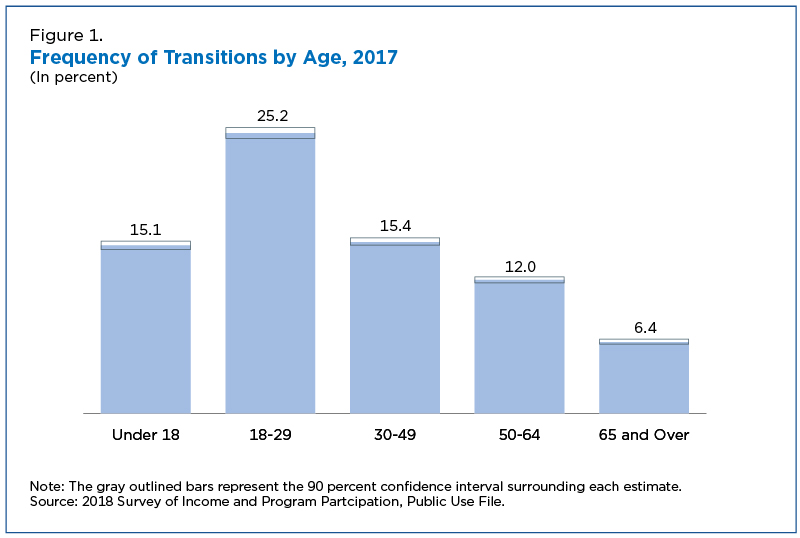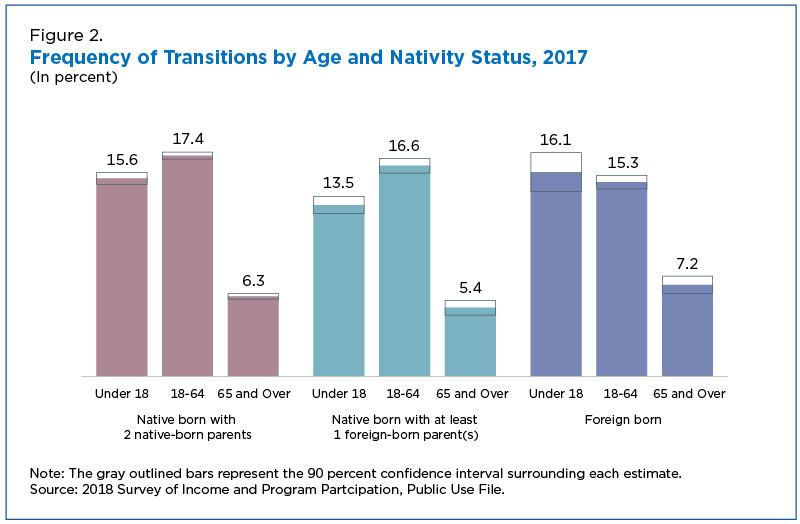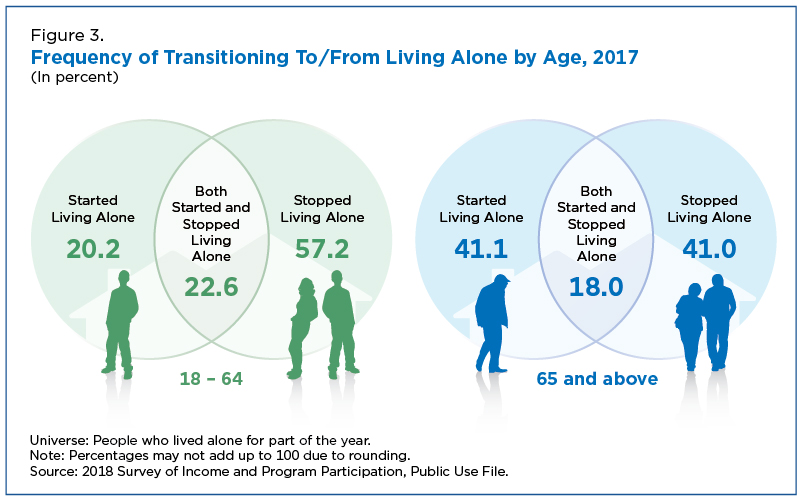Older Adults Who Are Foreign Born Less Likely to Live Alone Than Native Born
Young adults ages 18 to 29 are most likely to change their living arrangements, and foreign-born Americans ages 65 and over are less likely to live alone than their native-born counterparts, according to new U.S. Census Bureau data released this month.
Overall, in 2017, about 15% of the U.S. population experienced a change in living arrangements.
When living arrangements change, whether due to marital separation, a child moving away to college, or an elderly parent moving in, the transition can be disruptive for everyone involved.
Transitions in living arrangements have been shown to have a particular impact on children. Other research has explored the role of nativity status in household composition changes.
Since the U.S. Census Bureau’s Survey of Income and Program Participation (SIPP) collects information for each month of the calendar year preceding the interview, we can see how the frequency of changes in living arrangements varies across age groups.
When living arrangements change, whether due to marital separation, a child moving away to college, or an elderly parent moving in, the transition can be disruptive for everyone involved.
We can also study differences among native-born individuals with native-born parents, those who are native born with at least one foreign-born parent, and the foreign-born population.
This analysis uses newly released 2018 SIPP data to study differences in the frequency of household composition changes during 2017 by age (measured at the time of interview) and nativity status (based on whether individuals and/or their biological parents were born in the United States).
More information on transitions in the number of parents with whom children under 18 live is included in a Census Bureau brief.
Changes in Living Arrangements Varied Across Age Groups
In this analysis, we define transition as any change in the people with whom a person lived from one month to the next during 2017.
Adults ages 18 to 29 experienced transitions in living arrangements most frequently (Figure 1). Roughly one-quarter of those ages 18 to 29 experienced at least one change in their living arrangements during 2017.
The frequency of changes in living arrangements decreased with age. Just 6.4% of adults ages 65 and over experienced a change in who they lived with during 2017, while about 15% of children under 18 experienced a transition.
Variation by Nativity
There were also differences by age in the frequency of transitions across nativity groups (Figure 2).
Among native-born individuals with two native-born parents and native-born individuals with at least one foreign-born parent, children under 18 experienced fewer transitions in their living arrangements than adults ages 18 to 64.
However, this was not the case for the foreign born. The frequency of changes in living arrangements for children under 18 and adults ages 18 to 64 did not differ significantly among the foreign born.
Living Alone
Transitioning to or from living alone was not common among adults during 2017. Overall, 1.5% of those ages 18 and over began living alone at some point during 2017, while 2.6% of adults stopped living alone.
Transitions to or from living alone varied by age (Figure 3).
Among those who lived alone for only part of 2017, 80% of those ages 18 to 64 stopped living alone at some point during the year, compared to 59% of those ages 65 and over.
Meanwhile, just 43% of those ages 18 to 64 who lived alone for only part of the year started living alone at some point during the year, compared to 59% of those ages 65 and over.
However, many adults who lived alone for only part of 2017 both started and stopped living alone at some point during the year – about 23% of those ages 18-64 and about 18% of those ages 65 and over (the proportions for the two age groups did not differ significantly).
Past research has indicated that foreign-born individuals ages 65 and over live alone at lower rates than their native-born counterparts.
In December 2017, 20% of foreign-born individuals ages 65 and older lived alone, compared to 29% of native-born individuals in the same age group.
While older foreign-born individuals lived alone less often, the frequency of transitioning to and from living alone was not substantively different across nativity status among the population ages 65 and over.
Summary of Findings
Relative to other age groups, those ages 18 to 29 experienced transitions in living arrangements most frequently during 2017, and the relative frequencies of transitions for children and adults ages 18 to 64 varied across nativity status.
Among those who lived alone for only part of 2017, adults ages 65 and over started living alone at a higher rate than those ages 18 to 64. While foreign-born older adults lived alone less frequently than their native-born counterparts, the frequency with which they moved into or out of living alone did not differ by nativity status.
Zachary Scherer is a statistician in the Census Bureau’s Social, Economic, and Housing Statistics Division.
-
Stats for StoriesNational Spouses Day: January 26, 2024According to the Current Population Survey 2023 ASEC Supplement, there are some 133.1M married adults age 15+ in the U.S., not counting 4.6M who are separated.
-
Stats for StoriesUnmarried and Single Americans Week: September 17-23, 2023In 2022, about 132.3 million or 49.3% of Americans age 15 and over were unmarried, according to the Current Population Survey.
Subscribe
Our email newsletter is sent out on the day we publish a story. Get an alert directly in your inbox to read, share and blog about our newest stories.
Contact our Public Information Office for media inquiries or interviews.
-
America Counts StoryParents Juggle Work and Child Care During PandemicAugust 18, 2020Working mothers of school-age children bore the brunt of stay-at-home orders, taking personal leave or juggling childcare while working extra hours.
-
America Counts StoryHow State Marriage and Divorce Rates Stack UpFebruary 20, 2020New interactive data visual allows users to compare marriage and divorce rates across states for 2008 and 2018.
-
America Counts StoryStepdad or Mom’s Boyfriend?June 13, 2019Four out of 10 men living with the children of their spouse or partner and no biological or adopted children are not identified as the stepfather.
-
Business and EconomyWhat Is the Nonemployer Marine Economy?April 09, 2025Thirty states had nonemployer businesses in marine economy sectors, including six states in the Midwest with receipts totaling nearly $11 billion in 2022.
-
Business and EconomyEconomic Census Geographic Area Statistics Data Now AvailableApril 07, 2025A new data visualization based on the 2022 Economic Census shows the changing business landscape of 19 economic sectors across the United States.
-
Income and PovertyWhat Sources of Income Do People Rely On?April 02, 2025A new interactive data tool shows income sources for hundreds of demographic and economic characteristic combinations.
-
Business and EconomyBig Improvements to the Annual Integrated Economic Survey (AIES)March 26, 2025The Census Bureau is making several changes and enhancements to capture 2024 economic data based on feedback from last year’s survey.









